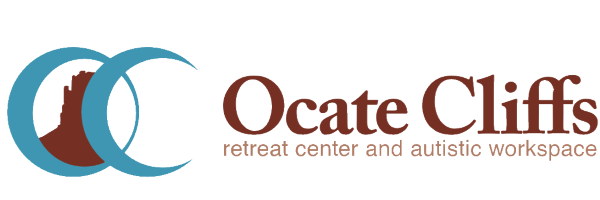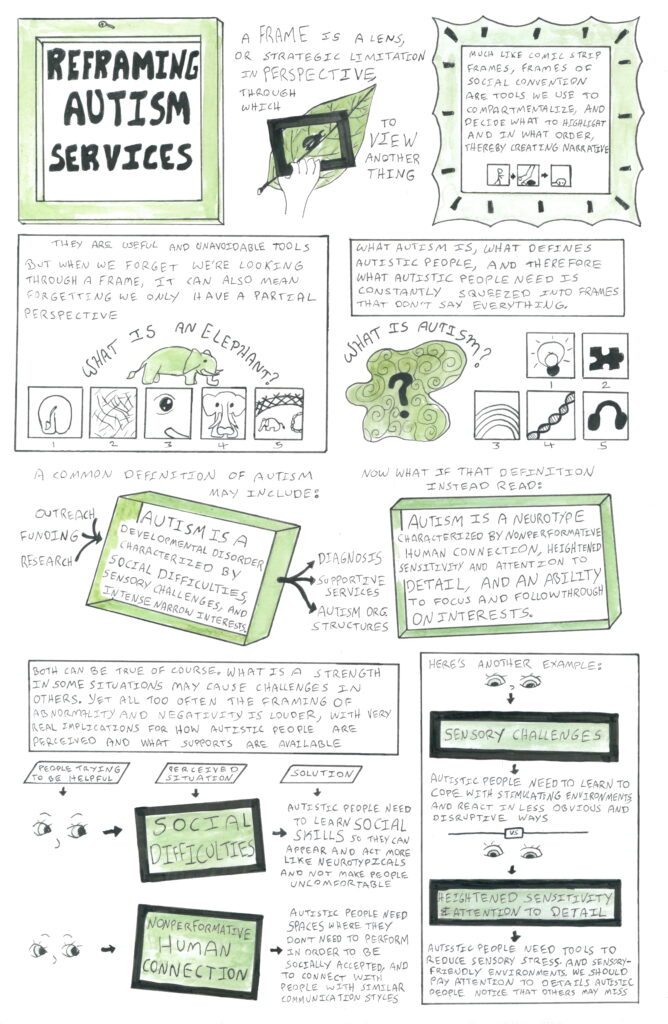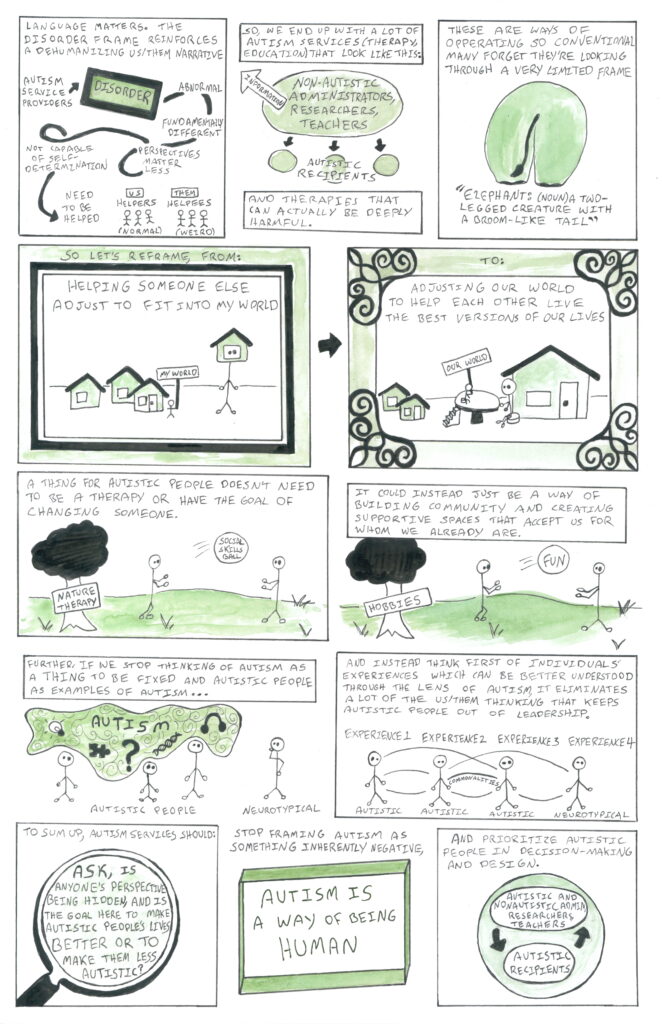This page contains three ways to learn about our family camp:
- Video (watch on YouTube)
- Comic Page 1 in full size and Page 2 in full size
- Full report with text & photos – please scroll down
Ocate Cliffs Family Camp 2022 Review
An Experiment in Radical Inclusion
This report was written by Sky, one of the camp staff. Photography is by Sky, LJ, Chris, and Rain.
INTRO
Ocate Cliffs family camp was an effort to put reframing in action. The pilot program took place over two long weekends in June 2022, bringing a collection of autistic and non autistic families and staff to rural northern New Mexico to connect and frolic in the woods. Creating something for the first time is challenging, but also is an opportunity to rewrite the code of what is expected. At 9,000 feet on top of a forested mesa, where it feels like you could reach up and grab the thunderheads rolling overhead, exposed to the extremes of both sun and rain, and where time itself feels stretched by the space of the sky, is the perfect setting for stretching expectations.
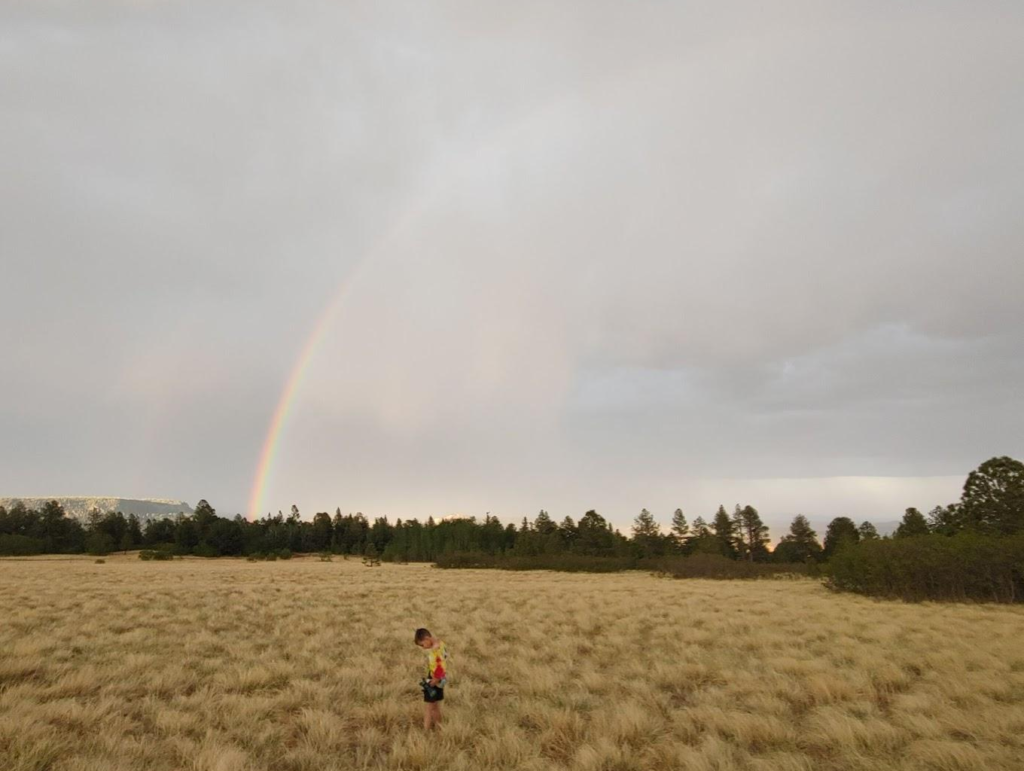
We perceive a need for radically inclusive autistic space, for autistic agency and leadership, and for families with autistic children to learn from autistic adults as well as one another. Radically inclusive means not only accommodating for autistic needs, but also having autistic people as designers of the space and erasing hierarchical boundaries on account of ability and neurotype. There is a lot of information on autism out there. Very little of it comes directly from autistic people. Families new to autism first finding out their child is autistic may be inundated into an overwhelming system of information telling them what therapies the child needs, what special education classes they should be in and how they should practice eye contact with the child, etc. Families need space to connect and find out what actually works. Further, established camps focusing on autism tend to be run largely by allistic (non-autisitic) people and have an ethos of either charity or therapy. In New Mexico, the only other autism program run by autistic people is Wilderwood Equine Therapy and Rescue. Ocate Cliffs family camp was thus an experiment falling into a very broad gap in services. We believe not only can autistic people be leaders and take care of autistic youth, but that doing so is better for autistic people overall, as autistic people often connect to one another at a level others do not. In designing this camp, we aimed to create a radically inclusive autistic space where autistic youth would be completely free to be who they are, to provide a transformative and educational experience for autistic adults, and to make space for parents of autistic youth to share experiences and broaden their own perceptions of autism.
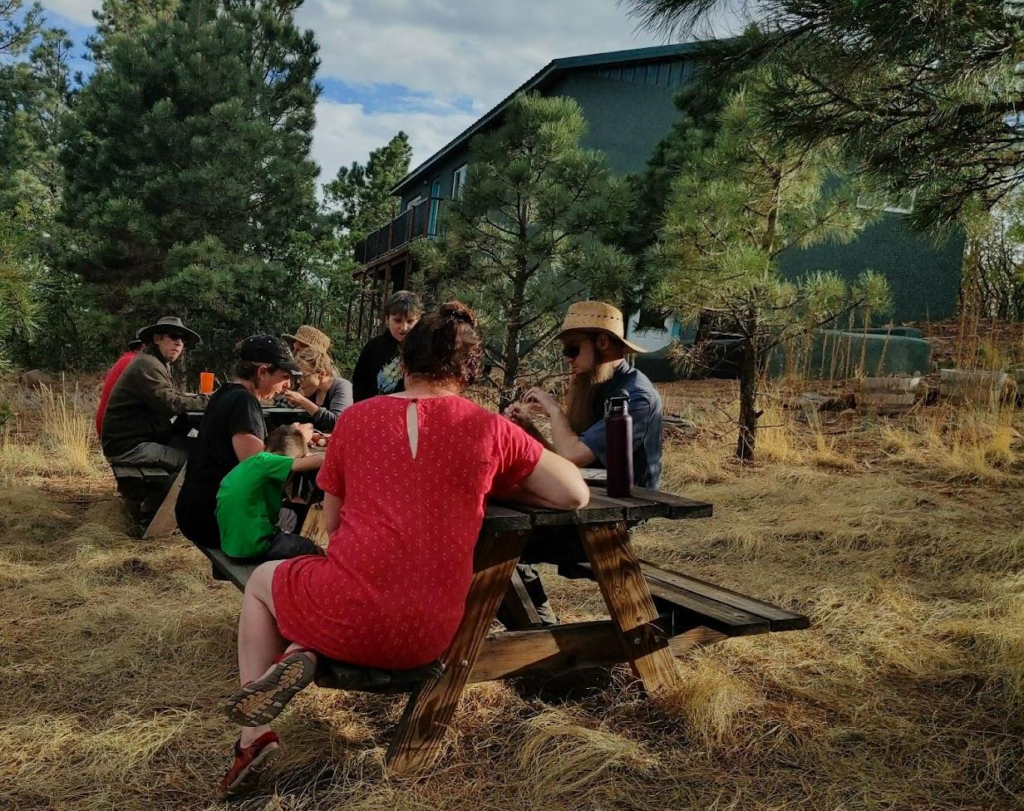

WHAT WE DID
Four families, or 12 people total participated in two long-weekend family camps. The camp was made possible through a grant from NEXT for AUTISM from the proceeds of Color the Spectrum. The grant enabled us to bring participants to the mountain free of charge and give stipends and travel reimbursements to staff. Families came from Santa Fe and Albuquerque and were recruited through word of mouth and support from NMAS (New Mexico Autism Society). In addition to director Star we had five staff of varying backgrounds and ages present. Staff met online in advance of camp to discuss values and goals, and planned the bulk of camp in a planning weekend prior to the first long weekend.
Families participated in a variety of large and small group activities, ranging from outdoor navigation and orienteering to improv skit creation, as well as other games and outdoor skills, hikes, crafts, and discussions. Morning and evening were set as activity blocks with separate parent and youth activities, with a long unstructured break in the middle and optional whole group activities after dinner. What follows is a more in-depth discussion of some elements of the design of the camp and its implementation as related to our goal of creating a radically inclusive space. These fall into the categories of flexibility and structure, age diversity, and autistic leadership.
FLEXIBILITY AND STRUCTURE
Creating a supportive space means meeting people where they are. What this meant for us was finding a balance of flexibility and structure, both in terms of day-to-day planning and the ways in which individual participants and staff showed up. We could not predict people’s interests, specific needs, or way of showing up in a group in advance, and as such maintained the ability to be open to in-the-moment adjustments as participants arrived. Within the general outline of meal times, morning and afternoon activity blocks, staff created a broad “menu” of activities which we could choose from and group people depending on interests. In our first weekend with three kids aged 14, 8, and 6, the older two ended up working better together, while the youngest gravitated towards more unstructured nature exploration time, and went on adventures on his own together with two staff. The eldest, C also sometimes chose to join parent discussion groups rather than “kids activity blocks.” The second weekend we had only one large family and they indicated preference for doing more things as a whole group and for less structured time.

The small scale of the camp, the high staff to participant ratio, and the presence of parents allowed us such great flexibility in meeting individual needs. Having participant numbers closer to our target of 6 families per weekend and 6-10 youths might help make groupings more dynamic especially for younger groups. However, small participant numbers didn’t seem to have much negative impact on individual experiences.
Flexibility also applies to the capacity at which staff and participants were able to show up. For many autistic people, a barrier to holding jobs, especially in a field like youth programs, which tends to be very fast paced and exhausting, is coping with sensory overload, overwhelm, and the constant demand for specific kinds of social external energy. A radically inclusive work environment would celebrate what each person contributes and challenge growth while allowing everyone equal access to meeting their own specific needs. Autistic people often cannot put their own needs on hold for the sake of a group. Whereas in typical workplaces, staff are generally expected to ignore interpersonal conflict and personal needs (or work it on their own) and maintain professional appearances, we found it essential to have conflict resolution and emotional check-ins as part of daily working structure. Some staff had no experience in youth programs or little traditional work experience in general but still contributed a lot. Having higher needs as staff need not be a barrier if the workplace is designed for it, such as with higher staff numbers, frequent breaks, and attention to interpersonal and emotional dynamics.
One staffer, Rain, had experience with working with natural materials to build structures. He led a group in collecting same-sized logs, cutting them, and lashing them together to make a durable enclosure. Participants of all ages learned some new knots, learned to use tools,
and planned the overall shape as a team. Another staffer, Jon, also works as a therapist and shared models for person-centered discussion and non-hierarchical facilitation to use with staff and in parent discussions. Prior to participant arrival, staff collaborated to design an orienteering course and construct a multi-step low-ropes course in the woods, which was a big hit for campers. Ocate Cliffs is a place that invites visitors, staff or otherwise, to try new things without having to already be good at them, to propose new projects, and leave a mark on the place in their own unique way. As a staff with significant experience in education and traditional camps, I have frequently run into the challenge of burnout from physical and social energy demands. The lack of pressure to perform and the deeper level of inclusivity at Ocate Cliffs was refreshing. Camp director Star reflected that, “Other non-autistic camps and retreats that I’ve staffed at have had staff that is more self-assured, more jovial, and more able to to keep their personal issues separate from the group. Those things make it easier, but also they tend to be more competitive and my opinions or any neurodivergent input have been pushed aside.”

YOUNG AND LESS YOUNG
An important element of the camp was the presence of multiple generations together in one space, activities meant not only for supporting youth but also educating parents, and a lack of rigid age-based distinctions. It is typical in autism services for autistic people to be held up to “developmental milestones” of skills normal to have at certain ages. We intentionally avoided making assumptions on what kids would be like based on age, or assuming older people would know more than younger people. Age tends to be less of a social determinant for autistic people in general, and thus it is natural for connections to occur across groups of broad age ranges.
It was important to have “family time” in the schedule as we lacked resources to run a youth sleepaway camp. It was also important to us to ensure time with parents and their children separated. We wanted to ensure kids had a chance to explore and express themselves away from the expectations and gaze of parents, as an experience common among autistic children is being infantilized and oversteered. It was good to see kids of all families present have a high degree of agency. For instance, both mom and youngest camper L were at first unwilling to separate, but soon he was leading staff on off-trail explorations. Another notable moment was hearing comments from siblings and parents of an autistic youngest sibling about his lack of ability (to play a game independently or solve a puzzle), in a way that suggested those types of comments were common. When he later demonstrated he was able to do those things he received positive validation from his family.
In addition to giving kids opportunities to explore independently, one goal of the camp was to give parents space away from their children to openly discuss their experiences, what has worked in their families and what challenges they’ve encountered. In semi-guided discussions with staff, parents discussed experiences in education, school bullying, neurodivergence and their own experiences growing up. There was a broad range of perspectives on autism even in that small group and the discussions gave space for sharing both shared and diverging experiences.

AUTISTIC (AND NOT)
It was critical for us to have autistic staff as leaders in creating autistic space, as models of adult autistic experiences, and because autistic adults are more likely to relate to the experience of being an autistic child. At the same time, we did not distinguish between autistic and allistic in terms of role, rank, or level of participation, which is the typical pattern for autism organizations. NMAS, for instance, has a by-default allistic board as well as an autistic “advisory board.” The camp was marketed towards families with at least one autistic child. Unsurprisingly, some adult family members were also autistic. All staff were autistic, though this was not a requirement to apply. In fact, at no point did we ask people about their disability or diagnosis status, or ask parents about the disability status of their kids, instead we only asked about needs and accommodations. Camp director Star reflected on the practice of meeting everyone where they are at and deprioritizing diagnosis labels, saying,“a disability isn’t an inherent quality of a person… It’s the accessibility to everything around us that makes the disability matter. If we create an environment that is accessible on all levels, the difference between disabled and non-disabled becomes very minimal.”
Many autism services for youth aim to model “normal” or “developmentally appropriate” behavior. We instead model adult autistic experiences to both youth and parents, thereby creating a shared understanding that it is okay to have autistic traits (visible or not visible) and that autistic people can grow up to have fulfilling lives. This “modeling” is not explicit, but rather an implicit culture created through the presence of autistic staff and the broad range of ways autism shows up, organic conversations and connections, and lack of structural hierarchies. Autistic people often connect with one another at a level that allistic people do not, so what may appear to be a lack of communication from an allistic perspective is actually just a communication style they are unfamiliar with. It should thus be intuitive and much more commonplace to have autistic people involved in supporting one another, and autistic adults supporting autistic youth.This applies to the full spectrum of autistic people, including those who are nonverbal and selectively verbal, and those with high support needs. Several parents noted how well staff worked with their kids, who had struggled or been ostracized at school and other camps. One kid, R, said that it was great to be “with other people who are full-on autistic,” and while we don’t have first-hand or verbal testimonies from all kids, seeing them not want to leave was indicative of a positive experience and feeling truly included.

“Autistic space” happens when the autistic way of being is the norm, when autistic people are not only accommodated but are also themselves the creators of culture in that space. Non-autistic people can be part of autistic space. In fact, having more non-autistics understand autistic space and integrating components of autistic space into the broader world is more fully inclusive than having a generally non-accomodating world with autistic-only bubbles. For us, autistic space showed up in openly communicating about needs, in impromptu dances and improv drum circles, and the rhythm established by staff during planning continuing when others arrived. Staff Jon reflected, “It felt a bit strange funnily enough, being around people who pretty much accepted me and one another for whomever they are.” The strangeness speaks to how rare complete inclusion is, how right it feels when you find pockets of it.

CHALLENGES AND GROWTH AREAS
By far the greatest barrier for us was outreach and recruitment. Both hiring staff and recruiting participants turned out to be more challenging than expected. None of the initial targets in our grant proposal of 6-10 autistic adult staff, 10-12 autistic children, and 8-12 parents and other family members were met. On the staff side, this is not that surprising as youth programs and camps across the board are having difficulty hiring at full capacity. We relied mostly on interpersonal connections (people who already knew about Ocate Cliffs) and local advertisement to recruit staff. Of those who showed up, a majority were already involved with Ocate Cliffs.
We recruited participants through email outreach with help from NMAS, through word of mouth, and through leafleting at an Albuquerque autism event. Recruitment challenges for participants can be partly explained by the remote location of the camp and condensed timeline for recruitment (grant approved in March, recruitment started in April for June camp). Additionally, running this camp for the first time we lacked a reputation and a returning staff and participant base. Because of this lack of reputation and it being free of charge, it may have not seemed like something that required serious commitment. A lot of people who expressed interest did not show up, including several last-minute cancellations. The four families who did come found out about camp through word of mouth (knowing a staff member) and through person to person contact from leafleting.
Anonymity and lack of social rank, and therefore access to broad support bases and networks that signify cultural legitimacy, are a challenge for many autistic people and autistic-led organizations. Autistic people tend to have small social networks and struggle with networking, and along with that, marketing in a way that taps into cultural codes of popularity and hype. Autistic-led autism organizations are in general much less well-funded and well known than mainstream counterparts, both because of autistic traits that make unifying and marketing difficult, but also because of systemic depowering of autistic people. We do wonder to what extent a tacit culture of downplaying the legitimacy of autistic initiatives played a role in recruitment challenges. People have a different conversational affect when sharing something they genuinely want you to buy into vs. something they feel is theoretically good but perhaps immature, an affect which is especially impactful when coming from a person or institution of power. Outreach support for Ocate Cliffs family camp may have conveyed a tone that we were a cute but unproven autism self-advocacy project rather than a legitimate program which will actually benefit autistic youth.
For Ocate Cliffs to grow and continue to host similar camps, we need connections and partnerships with larger autism organizations. We need a consistent source of funding in order to make this happen again. To reach the people who would most benefit from this kind of service, we need to straddle the divides of mainstream autism services and scattered autistic self-advocacy networks. Those with the greatest need tend to fall into mainstream autism institutions, far from the principles of autistic self-advocacy, while those institutions tend to not be truly inclusive of autistic people wanting to change how things are done.Should this camp (and other similar programs) develop a reputation as a legitimate and consistent program, it has the potential to depower the autism industry’s hold on how autism is framed and how autism support should be done.
In future camps,we aim to begin the outreach process earlier andpartner with people who know how to do networking. While it is important to retain maximum accessibility by being free of charge, we need some assurance of commitment from people who sign up, such as a refundable deposit. We would like to hire more staff to ensure covering all bases and leave space for people to step back if needed. While having a majority-autistic staff and an overall autistic space is a pillar we want to maintain, some non-autistic staff might create balance in terms of having more communication styles represented. We would adjust some program areas as we learn what works best, such as having moments of intentional crossover between parent and youth groups, while maintaining the overall structure of the camp. Specific feedback in how to better accommodate all needs is always welcome.

CONCLUDING WORDS
Despite the small turnout of the camp, the 2022 autistic family camp pilot program at Ocate Cliffs was successful on many accounts. We provided joyful experiences for youth and opportunities for self-expression, practiced autistic leadership, and fostered connections among parents. People walked away having been stirred by the experience, changed at an intangible level. Whether or not we repeat a camp of the exact same model, we hope the guiding structure and philosophy of this program will provide a template for us and other organizations going forwards. We need more autism services that are radically inclusive, and not just modeled as charity or therapy. This looks like autistic design and leadership in implementation, autistic adults serving as models and mentors for autistic youth, and erasure of social hierarchies and divisions in role and rank on account of ability or diagnosis. This also looks like built-in flexibility, meeting people as they are instead of comparing them to a norm or expectation, and work environments that are designed to be accommodating so that having needs is not a barrier to being able to show up. As Star says, “It’s really important to me that a lot more people experience a social environment where disability is minimized because of all the types of accessibility we keep working on that makes it possible for disabled people to operate on the same level, at the same type of power and same type of leadership as others.” This was just one camp over two weeks bringing a couple dozen people together on one mountain in New Mexico, but the intention that went into it was about more than those few days, for it was really just a radical experiment in the way we want everything to be.

